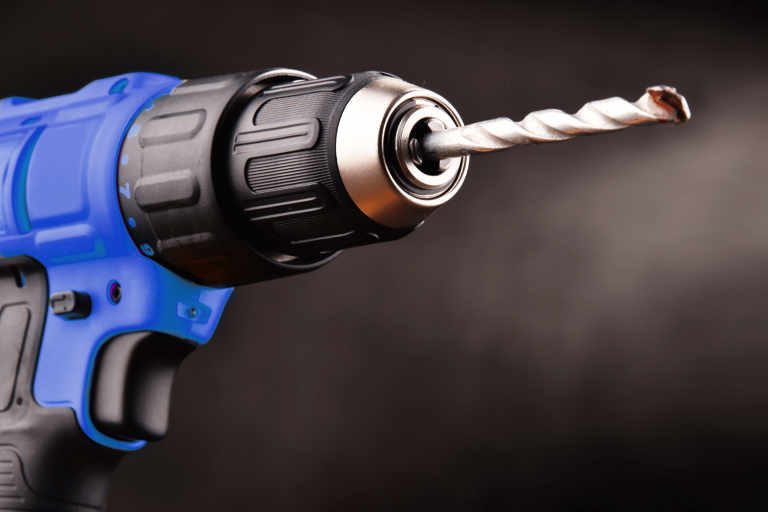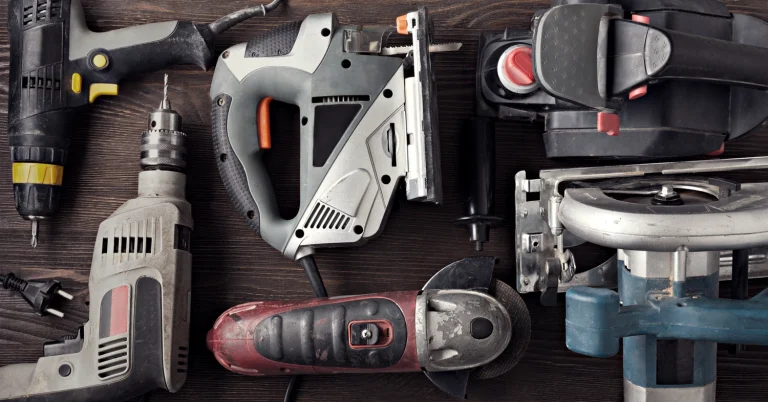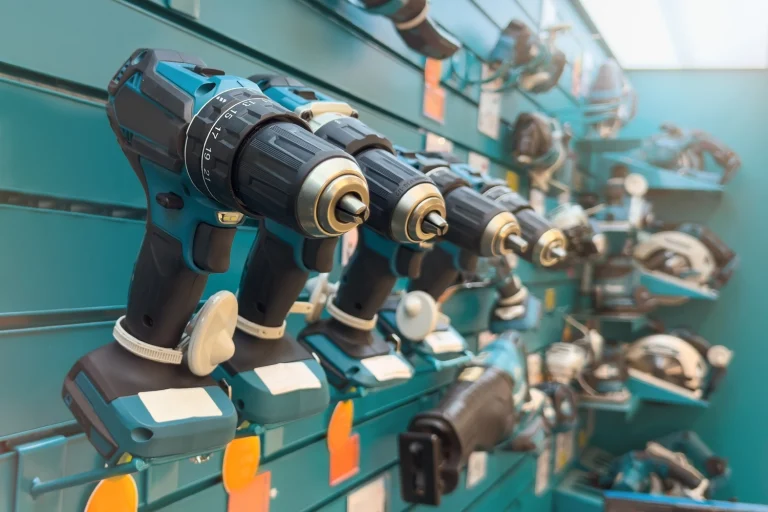Power Tool Maintenance: Tips for Long-Lasting Power
Are you tired of your power tools breaking down or not performing at their best? Don’t worry, we’ve got you covered.
In this article, we’ll guide you through the essential steps of power tool maintenance. From cleaning and preserving your tools to storing them properly, we’ll show you how to make your tools last longer.
Plus, we’ll share tips on lubrication, bit and blade sharpening, battery maintenance, and motor repair.
Say goodbye to tool troubles and join the power tool maintenance club!
Key Takeaways
- Regularly inspect tools for wear or damage
- Clean and lubricate power tools regularly
- Store tools in a clean and dry environment
- Follow a maintenance routine to prevent accidents

Power Tool Maintenance Checklist
To keep your power tools in optimal condition, follow this maintenance checklist.
Regular maintenance is crucial to ensure the longevity and performance of your power tools. Start by inspecting them for any signs of wear or damage, such as frayed cords or loose parts.
Next, clean the tools thoroughly, removing any debris or dust that may have accumulated.
Lubricate moving parts with appropriate oil or grease to ensure smooth operation.
Additionally, check and replace any worn-out or damaged blades or bits.
When not in use, store your power tools in a clean and dry environment, away from moisture and extreme temperatures.
Finally, always follow the manufacturer’s instructions for maintenance and safety guidelines.

Power Tool Maintenance Schedule – When to Check your Power Tools
Make sure you regularly check your power tools to ensure they’re in proper working condition. Following a power tool maintenance schedule is crucial to keep your tools functioning optimally and avoid any potential accidents. Here are three key items to include in your maintenance routine:
- Inspect the parts of your tool: Check for any loose or damaged components, such as screws, handles, or cords. Tighten or replace them if necessary to avoid any safety hazards.
- Look for signs of wear or damage: Examine the blades, bits, or cutting surfaces for any signs of dullness or chipping. Replace them as needed to maintain optimal performance and prevent accidents.
- Clean and lubricate: Remove any debris or dust from your power tools regularly. Apply appropriate lubrication to moving parts to ensure smooth operation and prolong the lifespan of your tools.
How Do You Clean and Preserve Power Tools to Make Your Tools Last
Regularly cleaning and preserving your power tools ensures their longevity and reliability, contributing to your sense of responsibility as a tool owner. To keep your tools in optimal condition, it’s essential to remove dirt and debris after each use.
Start by unplugging the tool and using a soft brush or cloth to gently wipe away any visible dirt. For hard-to-reach areas, compressed air can be used to dislodge debris.
When storing your tools, make sure they’re clean and dry to prevent rust and corrosion. Store them in a cool, dry place, away from moisture and direct sunlight.

How to Store your Power Tools
When storing your power tools, ensure they’re kept in a cool and dry place to prevent any rust or corrosion. Proper storage is crucial for maintaining the performance and longevity of your tools. Here are three practical tips to help you store your power tools effectively:
- Use original cases: Whenever possible, store your power tools in their original cases. These cases are designed to provide maximum protection and organization for your tools. They’ve compartments and foam inserts that keep your tools secure and prevent them from moving around, reducing the risk of damage.
- Clean and lubricate: Before storing your power tools, make sure to clean them thoroughly to remove any dirt, dust, or debris. Use a soft cloth or brush to wipe off any residue. After cleaning, apply a light coat of lubricant to prevent any parts from sticking or seizing up during storage.
- Secure storage: To ensure the safety and security of your power tools, consider investing in a lockable cabinet or toolbox. This won’t only protect your tools from theft but also keep them organized and easily accessible when needed.
How to Lubricate Your Power Tools to Minimize Wear and Tear
To minimize wear and tear on your tools, it’s important to regularly lubricate them with a light coat of oil or grease. Proper maintenance of your power tools is crucial in ensuring their longevity and optimal performance.
Lubrication acts as a protective barrier, preventing friction and reducing the risk of damage to the moving parts. When lubricating your power tools, ensure that you use the manufacturer-recommended lubricants for each specific tool. Apply the oil or grease to the designated areas, such as gears, bearings, and pivot points, using a clean and lint-free cloth or a precision applicator.
Be careful not to over-lubricate, as excessive lubrication can attract dust and debris, causing more harm than good. Regular lubrication won’t only minimize wear and tear but also contribute to the overall efficiency and functionality of your tools, ensuring that they perform at their best for years to come.

Power Tool Bit and Blade Sharpening
Using a sharpening stone or a grinding wheel, you can easily restore the sharpness of your power tool bits and blades. Sharpening these essential parts ensures optimal performance and extends the lifespan of your tools.
Here are three reasons why regular sharpening is crucial:
- Improved Efficiency: Dust and debris can accumulate on the cutting edges of your bits and blades, causing them to become dull and ineffective. By sharpening them regularly, you remove this buildup and restore their cutting ability, making your tools run more smoothly and efficiently.
- Cost Savings: Worn-out bits and blades can lead to poor quality work and increased material wastage. By sharpening them instead of replacing them, you save money in the long run, as well as reduce waste and unnecessary spending
- Safety First: Dull blades and bits can result in hazardous situations, as they require more force to cut through materials. By keeping your tools sharp, you ensure safer operation and minimize the risk of accidents.
Regular sharpening of your power tool bits and blades is an essential part of tool maintenance, improving efficiency, saving costs, and prioritizing safety.
Cordless Power Tool Battery Maintenance to Increase the Longevity
Now that you’ve learned about sharpening your power tool bits and blades, let’s move on to another important aspect of power tool maintenance – cordless power tool battery maintenance. Taking care of your battery is crucial for increasing the longevity and efficiency of your power tools.
To ensure optimal performance, it’s important to follow best practices when it comes to your cordless power tool batteries. Firstly, always make sure to fully charge the battery before using it. This will help maximize its runtime and prevent premature power loss. Additionally, avoid overcharging the battery as it can reduce its overall lifespan.
Regularly inspect the battery for any signs of damage or wear, such as cracks or leaks. If you notice any issues, it’s best to replace the battery to avoid any potential safety hazards.
Power Tool Motor Maintenance – When to Repair or Replace Worn Parts
When your power tool motor starts making unusual noises or vibrations, it’s a sign that worn parts may need to be repaired or replaced. Proper power tool maintenance is crucial to ensure optimal performance and longevity. Here are three reasons why repairing or replacing worn parts is essential:
- Safety: Worn parts can compromise the stability and functionality of your power tool, leading to accidents or injuries. By promptly repairing or replacing these parts, you can maintain a safe working environment.
- Efficiency: Worn parts can cause your power tool to work less efficiently, resulting in decreased productivity and increased frustration. By addressing these issues, you can restore your tool’s performance and complete tasks more effectively.
- Longevity: Neglecting worn parts can lead to further damage to your power tool motor. By repairing or replacing these parts in a timely manner, you can extend the lifespan of your power tool and avoid costly repairs or replacements in the future.
Power Tool Maintenance Tips and Troubleshooting
To ensure optimal performance and avoid potential issues, it’s important to regularly inspect and troubleshoot your power tools.
Proper care and maintenance of your power tools is essential for their longevity and efficient operation. Start by inspecting the power cords for any signs of damage or wear. Make sure to check the brushes and replace them if necessary.
Clean the air vents to prevent overheating and remove any debris that may have accumulated. Regularly lubricate the moving parts to ensure smooth operation.
If you encounter any issues with your power tools, troubleshooting is key. Check the power source, switches, and fuses to rule out any electrical problems. If the issue persists, consult the user manual or contact a professional for assistance.
Frequently Asked Questions
What Are the Most Common Power Tool Maintenance Mistakes to Avoid?
Avoiding the most common power tool maintenance mistakes is crucial. The following are some of the most common mistakes.
Neglecting Regular Cleaning: One biggie is not giving your tools a good cleaning after use. Sawdust, metal shavings, and debris can accumulate and clog up your tool’s ventilation or moving parts. So, grab a brush or compressed air and give them a good dust-off after each project.
Forgetting to Lubricate: Lubrication is the unsung hero of tool maintenance. Neglecting it can lead to premature wear and tear. Check your tool’s manual for lubrication points and follow the recommended schedule. Trust me; a little oil can go a long way in extending your tool’s life.
Ignoring Blade and Bit Maintenance: Blades and bits are like the teeth of your tool. Dull blades not only slow you down but can be dangerous. Keep them sharp and replace them when needed. Also, remember to clean them regularly to prevent buildup.
Overlooking Cord Care: For corded tools, don’t yank the cord when unplugging—this can damage the cord and connections. When storing, loosely coil the cord to prevent kinks and stress on the wires. And always inspect for fraying or damage before use.
Misusing Extension Cords: Using the wrong extension cord can harm your tool. Make sure it can handle the tool’s power needs and check for any damage. Oh, and keep it out of the way to avoid accidental cuts!
Skipping Safety Gear: Safety first, right? Neglecting safety gear is not just a maintenance mistake, but it’s a safety one too! Always wear the right safety gear like goggles, gloves, and hearing protection. Your tools will thank you, and so will your health.
Storing Tools Improperly: Leaving your tools exposed to the elements or in a damp garage is a recipe for rust and corrosion. Store them in a dry, cool place and consider using toolboxes or wall mounts to keep them organized and protected.
Ignoring Manufacturer Recommendations: Lastly, don’t ignore what the manufacturer tells you. Read the manual, follow maintenance instructions, and don’t push your tool past its limits. They know what they’re talking about!
Can Power Tools Be Stored in a Garage or Shed Without Affecting Their Performance?
Yes, power tools can be safely stored in a garage or shed without any negative impact on their performance. However, it is important to keep them in a dry and cool environment to prevent rust or damage.
Is It Necessary to Clean Power Tool Accessories Regularly, Such as Drill Bits or Saw Blades?
Regularly cleaning power tool accessories, such as drill bits or saw blades, is necessary. It ensures optimal performance, prolongs their lifespan, and reduces the risk of accidents. Neglecting maintenance can lead to decreased efficiency and potential damage.
How Often Should Power Tool Batteries Be Replaced?
To ensure optimal performance, power tool batteries should be replaced when they no longer hold a charge or provide sufficient power for your tasks. Regularly inspect their capacity and lifespan to determine when it’s time for a replacement.
Are There Any Specific Safety Measures to Take During Power Tool Maintenance?
Absolutely, safety should always be a top priority, even when you’re performing maintenance on your power tools. Here are some specific safety measures to keep in mind:
Turn Off and Unplug: Before you start any maintenance, make sure the tool is completely turned off and unplugged (for corded tools) or the battery is removed (for cordless tools). This prevents accidental starts while you’re working on it.
Wear Appropriate Safety Gear: Maintenance work can also be hazardous. So, wear the right safety gear, including safety glasses or goggles to protect your eyes from debris, gloves to shield your hands, and hearing protection if your work involves loud tools.
Work in a Well-Ventilated Area: Some maintenance tasks may involve dust, fumes, or hazardous materials. If you’re working with chemicals or doing tasks that produce dust or fumes, make sure you’re in a well-ventilated area or wear a mask or respirator as needed.
Use the Right Tools: When disassembling or reassembling your power tool, use the appropriate tools for the job. Using the wrong tool can damage your tool or lead to accidents.
Follow Manufacturer Guidelines: Always refer to the manufacturer’s maintenance instructions and guidelines in the tool’s manual. They provide essential information on how to safely perform maintenance and what precautions to take.
Secure Workpieces: If you’re working on a tool that requires securing a workpiece, like a blade or bit change, make sure it’s properly clamped or secured to prevent it from moving during maintenance.
Keep a First-Aid Kit Handy: Accidents can happen despite our best efforts. Having a basic first-aid kit nearby can be a lifesaver in case of minor injuries.
Inspect Cords and Connections: If you’re working on corded tools, pay close attention to the power cord and connections. Any signs of fraying or damage should be addressed immediately.
Dispose of Waste Safely: When you’re finished with maintenance, dispose of any waste, such as used blades, bits, or cleaning materials, in accordance with local regulations. Some materials may be considered hazardous and require special disposal.
Stay Focused: While working on your tools, stay focused on the task at hand. Avoid distractions and take your time to ensure that everything is done correctly and safely.







